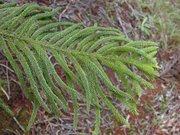Araucaria
|
|
| Araucaria | ||||||||||||
|---|---|---|---|---|---|---|---|---|---|---|---|---|
| Missing image Araucaria.columnaris1web.jpg Araucaria columnaris | ||||||||||||
| Scientific classification | ||||||||||||
| ||||||||||||
| Species | ||||||||||||
|
See text |
Araucaria is a genus of coniferous trees in the family Araucariaceae. There are 19 species in the genus, with a highly disjunct distribution in New Caledonia (where 13 species are endemic), Norfolk Island, eastern Australia, New Guinea, Argentina, Chile, and southern Brazil. Many if not all current populations are relictual and restricted. They are found in forest and maquis, with an affinity for exposed sites. These columnar trees are living fossils, dating back to early in the dinosaur age. Fossil records show that the genus also formerly occurred in the northern hemisphere until the end of the Cretaceous period.
The genus is familiar to many people as the genus of the distinctive Monkey-puzzle Araucaria araucana. The genus is named after the Arauco Indians of central Chile whose territory incorporates natural stands of this species, where it is known as the Pehuén. These Native Americans, who name themselves the Pehuenche ('people of the Pehuén'), harvest the seeds extensively for food. No distinct vernacular name exists for the genus; many are erroneously called 'pine', despite their being only very distantly related to pines (Pinus).
They are mainly large trees with a massive erect stem, reaching a height of 30-80 m. The horizontal, spreading branches grow in whorls and are covered with leathery or needle-like leaves. In some species, the leaves are narrow awl-shaped and lanceolate, barely overlapping each other, in others they are broad and flat, and overlap broadly. The trees are mostly dioecious, with male and female cones found on separate trees, though occasional individuals are monoecious or change sex with time. The female cones, usually high on the top of the tree, are globose, and vary in size between species from 7-25 cm diameter. They contain 80-200 large, edible seeds, similar to pine nuts though larger. The male cones are smaller, 4-10 cm long, and narrow to broad cylindrical, 1.5-5 cm broad.
Classification & species list
There are two sections in the genus, sometimes treated as separate genera:
- Section Araucaria. Leaves broad; cones more than 12cm diameter; seed germination hypogeal.
- Araucaria angustifolia. Paraná Pine (obsolete: Brazilian Pine, Candelabra Tree). Southeastern Brazil, northeastern Argentina.
- Araucaria araucana. Monkey-puzzle or Pehuén (obsolete: Chile Pine). Central Chile & western Argentina.
- Araucaria bidwillii. Bunya-bunya. Eastern Australia.
- Araucaria hunsteinii. Klinki. New Guinea.
- Section Eutacta. Leaves narrow, awl-like; cones less than 12cm diameter; seed germination epigeal.
NorfolkIslandPineKerikeri.jpg
- Araucaria bernieri. New Caledonia.
- Araucaria biramulata. New Caledonia.
- Araucaria columnaris. Cook Pine. New Caledonia.
- Araucaria cunninghamii. Moreton Bay Pine, Hoop Pine. Eastern Australia, New Guinea.
- Araucaria heterophylla. Norfolk Island Pine. Norfolk Island.
- Araucaria humboldtensis. New Caledonia.
- Araucaria laubenfelsii. New Caledonia.
- Araucaria luxurians. New Caledonia.
- Araucaria montana. New Caledonia.
- Araucaria muelleri. New Caledonia.
- Araucaria nemorosa. New Caledonia.
- Araucaria rulei. New Caledonia.
- Araucaria schmidii. New Caledonia.
- Araucaria scopulorum. New Caledonia.
- Araucaria subulata. New Caledonia.
Uses
Some of the species are relatively common in cultivation because of their distinctive, formal symmetrical growth habit. Several species are economically important for timber production and the edible seeds.
External link
Gymnosperm Database: Araucaria (http://www.botanik.uni-bonn.de/conifers/ar/ar/index.html)
Araucaria is the pseudonym used by the cryptic crossword compiler John Graham (compiler).
da:Abeskrækslægten (Araucaria) fr:Araucaria it:Araucaria pt:Araucaria

